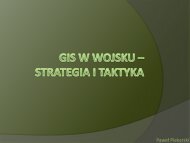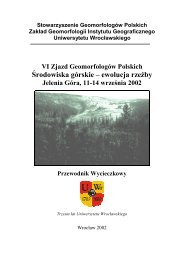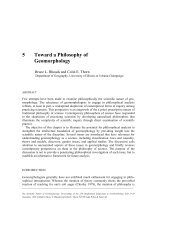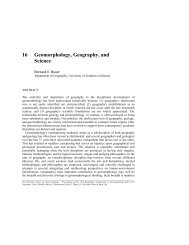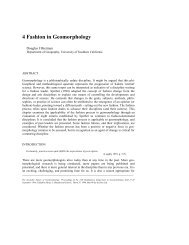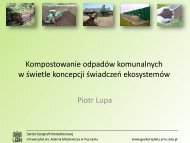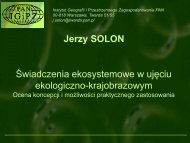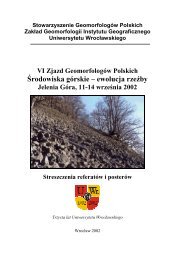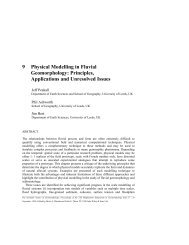Meyniana
Meyniana
Meyniana
You also want an ePaper? Increase the reach of your titles
YUMPU automatically turns print PDFs into web optimized ePapers that Google loves.
<strong>Meyniana</strong> 57 Seite 117-132 8 Abb., 1 Tab. Kiel, (Nov.) 2005<br />
Sediment dynamics and hydrodynamics<br />
during low river discharge conditions<br />
in the Nha Trang Bay, Vietnam<br />
WITOLD SZCZUCIÑSKI, ROBERT JAGODZIÑSKI, NGUYEN TRUNG THANH,<br />
ADAM KUBICKI & KARL STATTEGGER<br />
SZCZUCIÑSKI, WITOLD; JAGODZIÑSKI, ROBERT; NGUYEN TRUNG THANH;<br />
KUBICKI, ADAM & STATTEGGER, KARL, 2005: Sediment dynamics and<br />
hydrodynamics during low river discharge conditions in Nha Trang Bay,<br />
Vietnam. (Sedynamik und hydrodynamik während niedrigwasser Perioden<br />
in Nha Trang Bay, Vietnam).- <strong>Meyniana</strong>, 57:117-132, 8 fig., 1 tab., Kiel.<br />
SE Asia is one of the most important sources of particulate matter transported<br />
to the ocean. However, the discharge is seasonal due to the<br />
monsoonal climate. The results of our investigation on sedimentation and<br />
water circulation in the Nha Trang Bay (Vietnam) during a period of lowest<br />
river discharge and neap tide are presented. The major hydrological factors<br />
are thermal stratification of the water column and its thorough mixing during<br />
short periods of local winds. The Cai River water influence as the major<br />
freshwater source is limited to less than 2.8 km from its mouth. Suspended<br />
particulate matter concentrations are very low between 0.03-4.3 mg dm -3 ,<br />
only one sample reached 8.9 mg dm -3 . Downward particulate matter flux<br />
determined with sediment traps at a station 2.8 km off the river mouth is<br />
very low: 0.77 g m -2 day -1 at 2 m water depth and 5.36 g m -2 day -1 at 12 m<br />
water depth, about 3 m above the bottom. The bottom sediments in the<br />
Nha Trang Bay are composed mainly of sands. Along with sediment trap<br />
results, it shows that no significant accumulation occurs in the dry season.<br />
It is thus evident that fine material, which is expected to be deposited on the<br />
bay bottom during the rainy season, as observed in satellite images, must<br />
have been reentrained and advected further offshore.<br />
Dr. W. SZCZUCIÑSKI & Dr. R. JAGODZIÑSKI, Inst. of Geol., A. Mickiewicz Univ.,<br />
Maków Polnych 16, 61-686 Poznañ, Poland. Email: Witold.Szczucinski@euvfrankfurt-o.de<br />
NGUYEN TRUNG THANH, M.Sc., Inst. of Marine Geol. & Geophys., Vietnamese<br />
Acad. of Sci. and Tech., 18 Hoang Quoc Viet Street, Hanoi, Vietnam.<br />
A. KUBICKI, M.Sc. & Prof. Dr. K. STATTEGGER, Inst. of Geosci., Christian-<br />
Albrecht-Univ., Olshausenstrasse 40, 24118 Kiel, Germany.<br />
Zusammenfassung<br />
Der saisonale monsungesteuerte Sedimenteintrag aus Flüssen in Südost-Asien ist<br />
für den globalen Sedimenttransport in den Weltozean von großer Bedeutung. Als Fallstudie<br />
wurden Zirkulation und Sedimentation in der Bucht von Nha Trang, Süd-Vietnam




